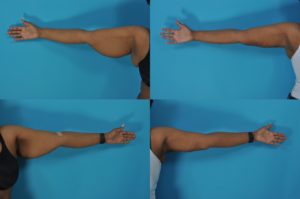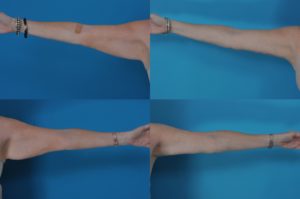INTRODUCTION
Arm Lifts
Extra loose skin of the upper arms is a common problem and can be a source of embarrassment to women. They may not be able to go sleeveless, even during the summer. If the degree of skin laxity is mild, I recommend liposuction alone. However, if there is a lot of loose skin, it may be best to proceed directly to a skin excision procedure, called brachioplasties.
Patients sometimes ask if it is possible to keep the incision contained up in the axillae (“arm pits”). They even show me by pinching the skin of the armpit area to demonstrate. The problem with this mini-lift is that the degree of improvement is limited to just the uppermost part of the arm. For most women, this is not enough.
This problem is similar to excess skin of the inner thighs, which has been traditionally treated in the past with the disappointing inner thigh lift procedure, using an incision limited to the groin crease, but is now more commonly treated with a longitudinal incision down the inner thigh which produces a much better tightening effect.
PHOTOS OF ARM LIFT PATIENTS
R.B., Age 41
Procedure: Brachioplasties, liposuction of arms and axillae. This patient had massive weight loss.
Before, 3 months.
H.G., Age 45
Procedure: Brachioplasty. Lost 200 pounds by diet and exercise.
Before, 3 months.
S.H., Age 47
Procedure: Brachioplasties, liposuction of arms and axillae.
Before, 3 months.
M.M. Age 51
Procedure: Brachioplasties, liposuction of arms and axillae, and breast reduction plus implants. This patient lost over 100 pounds.
Before, 6 months.
S.S., Age 52
Procedure: Brachioplasties
Before, 6 months after

Before, 6 months after

J.B. Age 56
Procedure: Brachioplasties and liposuction of arms and axillae.
Before, 6 months.
C.A., Age 57
Procedure: Brachioplasties, Liposuction of arms and axillae.
Before, 3 months after
B.W., Age 64
Procedure: Brachioplasties, liposuction of arms and axillae
Before, 2 months after
L.R., Age 65
Brachioplasties, breast lift, and abdominoplasty.
Before, 3 months after
P.M., Age 66
Procedure: Brachioplasties, liposuction of arms and axillae
Before, 3½ months after
Preoperative marking is performed. The arm is often pretreated with liposuction to remove extra fat and also develop a tissue plane to make removing the skin easier.
The Incision
An elliptical incision is used to cut out the extra loose skin. A traditional approach is to make the incision in the bicipital groove, which is easily visible on the front of the arm. I prefer to use a posteromedial incision, so that the scar is positioned along the free margin of the upper arm. This way it is not conspicuous when the arm is in a resting position at the patient’s side. The scar ends up as a line running down the inseam of the arm from the armpit to just above the level of the elbow.
There is not much pain after this procedure. The dressings are removed the day after surgery. Steri-Strips are left on or replaced if they have become saturated. Bruising and swelling are to be expected of course, but the improved tightness of the skin is already obvious.
“Dog Ears”
I have occasionally treated a “dog ear” of either the upper (“proximal”) or lower (“distal”) end of the scar if the expected puckering does not settle down completely.
Scarring
Like all scars, sometimes the scar spreads and this may be improved by revising the scar at a later date, when there is less tension on the wound.
Numbness
An important sensory nerve (“medial antebrachial cutaneous nerve”) runs down the inside of the upper arm. It is important for the surgeon to avoid injuring this nerve, which might cause a painful neuroma. Typically, I resect the tissue more posteriorly, and only after anesthetic infiltration, which helps expand the subcutaneous plane, making nerve injury very unlikely.
Hematoma
Hematomas are unusual. The vessels are small and easily controlled with cautery. There is some compression from the tissue closure which helps to avoid a dead space. Drains are not routinely used.
Seromas
This is a commonly reported complication. With judicious liposuction and the avoidance of cutting cautery, this complication can be avoided.
Getting Back to Normal
- The dressings come off when you return to the office the day after surgery.
- Bruising and swelling are normal. It is not unusual for the bruising to continue down the forearm.
- There is no garment that you need to wear. However, some patients prefer the gentle compression of tight-fitting long-sleeved athletic wear. One popular manufacturer is Under Armour.
- Leave the Steri-Strips in place. They come off about a week after surgery.
- Start bathing normally again the day after surgery, after the dressings are removed.
- At first, there is some normal gathering and irregularity along the incision. This smooths out on its own.
- Vigorous physical activities should be deferred for about a month. Normal day-to-day activities may be resumed right away.
Q: Is it painful?
A: No.
Q: Can you keep the incision hidden in the armpit?
A: No. This does not allow sufficient skin tightening.
Q: How visible is the scar?
A: It is exposed when you are sleeveless. However, it is kept close to the posterior border, where it is typically not obvious. Patients find the scar preferable to loose skin. If the skin is minimally saggy, liposuction is done instead.

